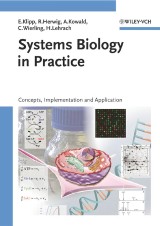Details

Systems Biology in Practice
Concepts, Implementation and Application1. Aufl.
|
117,99 € |
|
| Verlag: | Wiley-Blackwell |
| Format: | |
| Veröffentl.: | 15.07.2008 |
| ISBN/EAN: | 9783527604883 |
| Sprache: | englisch |
| Anzahl Seiten: | 485 |
DRM-geschütztes eBook, Sie benötigen z.B. Adobe Digital Editions und eine Adobe ID zum Lesen.
Beschreibungen
Presenting the main concepts, this book leads students as well as advanced researchers from different disciplines to an understanding of current ideas in the complex field of comprehensive experimental investigation of biological objects, analysis of data, development of models, simulation, and hypothesis generation. <br> It provides readers with guidance on how a specific complex biological question may be tackled: <br> - How to formulate questions that can be answered<br> - Which experiments to perform<br> - Where to find information in databases and on the Internet<br> - What kinds of models are appropriate<br> - How to use simulation tools<br> - What can be learned from the comparison of experimental data and modeling results<br> - How to make testable predictions.<br> The authors demonstrate how mathematical concepts can illuminate the principles underlying biology at a genetic, molecular, cellular and even organism level, and how to use mathematical tools for analysis and prediction.
Preface. <p>Foreword.</p> <p><b>Part I: General Introduction.</b></p> <p>1. Basic Principles.</p> <p>2. Biology in a Nutshell.</p> <p>3. Mathematics in a Nutshell.</p> <p>4. Experimental Techniques in a Nutshell.</p> <p><b>Part II: Standard Models and Approaches in Systems Biology.</b></p> <p>5. Metabolism.</p> <p>6. Signal Transduction.</p> <p>7. Selected Biological Processes.</p> <p>8. Modeling of Gene Expression.</p> <p>9. Analysis of Gene Expression Data.</p> <p>10. Evolution and Self-organization.</p> <p>11. Data Integration.</p> <p>12. What’s Next?</p> <p><b>Part III: Computer-based Information Retrieval and Examination.</b></p> <p>13. Databases and Tools on the Internet.</p> <p>14. Modeling Tools.</p> <p>Subject Index.</p>
"...this is one book that I bought for myself as soon as it was published." (<i>British Journal of Occupational Therapy</i>, February 2008) <p>"This resource does an admirable job of bringing the readers to a level where they can pursue more advanced study and research." (<i>IEEE Engineering in Medicine and Biology Magazine</i>, January/February 2008)</p> <p>"This rapid survey of a developing field is ideal for beginning graduate students…" (<i>CHOICE</i>, December 2005)</p> <p>"This is a timely volume that should be welcomed both by practising systems biologists and by newcomers to the field.... I expect to consult it regularly over the foreseeable future, and I am confident that biologists everywhere will benefit from having a copy to hand." (<i>Theoretical Biology and Medical Modelling</i>)</p> <p>"The authors manage to cover an astoundingly wide range of topics and to present the great potential of systems biology to the reader. The first introductory part makes it an ideal book for researchers from neighbouring disciplines, who benefit from the compact and clearly written basics in biology and mathematics. But the main area of application will be as textbook for the growing number of students interested in bioinformatics, systems biology and theoretical biology. With its 14 chapters, 450 pages and many diagrams and examples it provides plenty of material for lecturing." (Arzneimittel<i>-Forschung/Drug Research</i>)</p>
<b>Edda Klipp</b> (born 1965) studied biophysics at the Humboldt University Berlin, receiving her PhD in theoretical biophysics. Since 2001 she has been head of the Kinetic Modeling Group. A member of the Yeast Systems Biology Network, her research interests include mathematical modeling of cellular systems, signal transduction, systems biology, and text mining. <p><b>Ralf Herwig</b> (born 1967) studied mathematics and physics at the TU Berlin and Free University Berlin and wrote his PhD on statistical clustering methods. He has been a group leader in bioinformatics since 2001 and works on several projects covering genomics, proteomics and systems biology.</p> <p><b>Axel Kowald</b> (born 1963) holds a PhD in mathematical biology from the National Institute for Medical Research, London. He has worked at the University of Manchester, the Institute for Advanced Studies in Budapest, and the Humboldt University Berlin. His current research interests focus on the mathematical modeling of processes involved in the biology of aging and systems biology.</p> <p><b>Christoph Wierling</b> (born 1973) studied biology at the University of Münster, graduating in 1999. Currently he is working as a PhD student on the modeling and simulation of biological systems and the development of computational tools for systems biology.</p> <p><b>Hans Lehrach</b> (born 1946) studied chemistry in Vienna and Braunschweig, receiving his PhD from the Max Planck Institute for Experimental Medicine. He is director of the MPI for Molecular Genetics and was spokesman for the German Human Genome. Among others, he is a member of EMBO, on the project committee of the National Genome Research Network, and a fellow of the American Association for the Advancement of Science. His research interests focus on functional genomics, technology development and systems biology.<br /> All the authors currently work at the Max Planck Institute for Molecular Genetics in Berlin.</p>
Presenting the main concepts, this book leads students as well as advanced researchers from different disciplines to an understanding of current ideas in the complex field of comprehensive experimental investigation of biological objects, analysis of data, development of models, simulation, and hypothesis generation. It provides readers with guidance on how a specific complex biological question may be tackled: <ul> <li> <div>How to formulate questions that can be answered</div> </li> <li> <div>Which experiments to perform</div> </li> <li> <div>Where to find information in databases and on the internet</div> </li> <li> <div>What kinds of models are appropriate</div> </li> <li> <div>How to use simulation tools</div> </li> <li> <div>What can be learned from the comparison of experimental data and modeling results</div> </li> <li> <div>How to make testable predictions.</div> </li> </ul> <p>The authors demonstrate how mathematical concepts can illuminate the principles underlying biology at a genetic, molecular, cellular and even organism level, and how to use mathematical tools for analysis and prediction.</p>

















